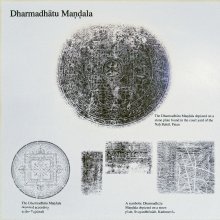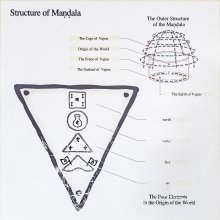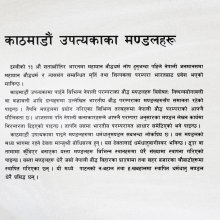Vajravali, Vajrāvalī, Vajravāli, Vajra-avali: 5 definitions
Introduction:
Vajravali means something in Buddhism, Pali, Hinduism, Sanskrit, the history of ancient India. If you want to know the exact meaning, history, etymology or English translation of this term then check out the descriptions on this page. Add your comment or reference to a book if you want to contribute to this summary article.
Images (photo gallery)
In Buddhism
Tibetan Buddhism (Vajrayana or tantric Buddhism)
Source: Brill: Śaivism and the Tantric Traditions (tantric Buddhism)Vajrāvalī (वज्रावली) by Abhayākaragupta is the name of a text within Tantric Buddhism dealing with construction manual for monasteries etc.—Tantric Buddhism also produced a number of manuals which are closely comparable to Śaiva Pratiṣṭhātantras and Paddhatis. Of these, three manuals are particularly rich in information: the Kriyāsaṃgrahapañjikā of Kuladatta, the Vajrāvalī of Abhayākaragupta, and the Ācāryakriyāsamuccaya of Jagaddarpaṇa or Darpaṇācārya, which incorporates much of the Vajrāvalī but adds some new materials (Sanderson 2009, 126–127, note 293).
Source: OSU Press: Cakrasamvara SamadhiVajrāvalī (वज्रावली) refers to the “vajra-fire”, according to the Cakrasaṃvara Samādhi [i.e., Cakrasamvara Meditation] ritual often performed in combination with the Cakrasaṃvara Samādhi, which refers to the primary pūjā and sādhanā practice of Newah Mahāyāna-Vajrayāna Buddhists in Nepal.—Accordingly, “Reflect, absorbed in great bliss. Therein vajra fire (vajrāvalī), lotus fire, blazing fire, Again Śumbha Niśumbha Hūṃ Phaṭ”.

Tibetan Buddhism includes schools such as Nyingma, Kadampa, Kagyu and Gelug. Their primary canon of literature is divided in two broad categories: The Kangyur, which consists of Buddha’s words, and the Tengyur, which includes commentaries from various sources. Esotericism and tantra techniques (vajrayāna) are collected indepently.
India history and geography
Source: Wikipedia: India HistoryVajravāli (वज्रवालि).—Abhayākaragupta’s magmum opus, the Vajravāli, is a “grand synthesis of tantric liturgy” which developed a single harmonized tantric ritual system which could be applied to all Tantric Buddhist mandalas. In the Vajravāli, Abhayākaragupta synthesized previous Tantric ritual traditions such as those of Puṇḍarīka and Padmavajra and created a standardized “sequence of rituals” (prakriyā).

The history of India traces the identification of countries, villages, towns and other regions of India, as well as mythology, zoology, royal dynasties, rulers, tribes, local festivities and traditions and regional languages. Ancient India enjoyed religious freedom and encourages the path of Dharma, a concept common to Buddhism, Hinduism, and Jainism.
Languages of India and abroad
Sanskrit dictionary
Source: Cologne Digital Sanskrit Dictionaries: Aufrecht Catalogus CatalogorumVajrāvalī (वज्रावली) as mentioned in Aufrecht’s Catalogus Catalogorum:—[tantric] Kāṭm. 12.
Source: Cologne Digital Sanskrit Dictionaries: Monier-Williams Sanskrit-English DictionaryVajrāvālī (वज्रावाली):—[from vajra > vaj] f. Name of a Tantra [work]
Sanskrit, also spelled संस्कृतम् (saṃskṛtam), is an ancient language of India commonly seen as the grandmother of the Indo-European language family (even English!). Closely allied with Prakrit and Pali, Sanskrit is more exhaustive in both grammar and terms and has the most extensive collection of literature in the world, greatly surpassing its sister-languages Greek and Latin.
See also (Relevant definitions)
Partial matches: Vajra, Avali.
Full-text: Abhayakaragupta, Acaryakriyasamuccaya, Jagaddarpana, Darpanacarya, Shishyapratishtha, Pratima, Pratishtha, Shishya, Pratimapratishtha, Hulunda, Shunyata.
Relevant text
Search found 1 books and stories containing Vajravali, Vajrāvalī, Vajravāli, Vajrāvālī, Vajra-avali, Vajra-āvalī; (plurals include: Vajravalis, Vajrāvalīs, Vajravālis, Vajrāvālīs, avalis, āvalīs). You can also click to the full overview containing English textual excerpts. Below are direct links for the most relevant articles:
Blue Annals (deb-ther sngon-po) (by George N. Roerich)
Chapter 10 - Origin of the Adamantine Garland (Vajrāvali) and other cycles < [Book 14 - Great Compassion Cycle]
Chapter 12 - Teurapa (rte'u ra pa'i skabs) < [Book 14 - Great Compassion Cycle]


